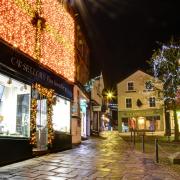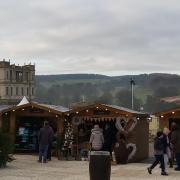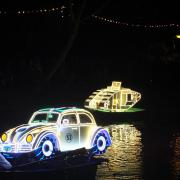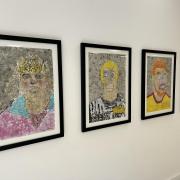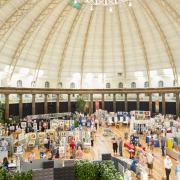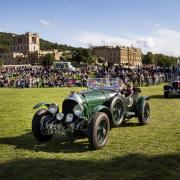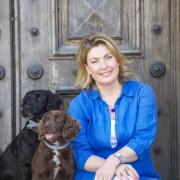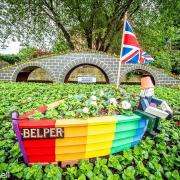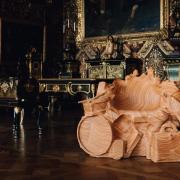Works by artists from Brueghel and Landseer to Jeff Koons and Ben Long are the focus of this season’s main exhibition at Chatsworth House. Pat Ashworth reports

When Chatsworth puts on an exhibition, it’s never a mere display of fine art in one of its magnificent state rooms or galleries. Exhibition material is always intricately woven into the history of the House and the Cavendish family, inviting a fresh and quirky look at things familiar and a delight in new additions.
Take the Painted Hall, for example. I’ve lost count of the number of times I’ve stood and exulted in this space. With the opening this month of The Dog: A Celebration at Chatsworth, visitors ascending that glorious staircase will be keenly observed from its vantage point at the top by a very large poodle, the work of the contemporary American artist, Jeff Koons. And they’ll already have encountered three venerable canine guests in the shape of Joseph Gott’s A greyhound with her two puppies suckling, after the Antique A pair of greyhounds and Elisabeth Frink’s Standing Dog.
The exhibition is the brainchild of the Duchess of Devonshire, who in her own words has ‘lived with and loved dogs for as long as I can remember. They are an integral part of my life and every day I see the importance of dogs reflected in the Collection at Chatsworth.’ It celebrates not only dogs as companions, pets and friends but dogs in art and working dogs on this great country estate – ‘a full span of history,’ says Alex Hodby, Curator of Exhibitions and Engagement, who has worked with independent curator Tessa Wild on the project. ‘There are layers and layers of looking and thinking to be done in every space.’
There have been notable dog-lovers among the Dukes of Devonshire, not least the Sixth Duke, who had many dogs and who kept wonderful records of acquisitions such as the Joseph Gott greyhound, normally to be found in the Sculpture Gallery. Commissioned portraits of his own and other beloved animals will hang together in an intimate space; fascinating archival material on display includes a poem written by Duchess Georgiana, a recipe for dealing with a bite from a mad dog and letters between the Ninth Duke and Duchess detailing the antics of their naughty puppy, Punch.

Some of Nicola Hicks’ beautifully animated bronze greyhounds will be seen running the length of the Great Chamber. And the windows on this side of the House yield stunning views of one of the exhibition’s main highlights – Ben Long’s eight-metre-high dog made of scaffolding. Framed on the house, it looks as though it’s hanging in the air, a drawing in space. The scaffolding links are welded, yielding flashes of light. Monumental and huge, it’s also permeable and so part of the landscape, a visionary commission that is so very Chatsworth. Alex Hodby describes it as ‘an amazing herald to the exhibition.’
Exhibits in the State Drawing Room include a panel by Brueghel, a fascinating study of different hounds that shows the artist’s mind at work. Visitors will be moved here by the Oxburgh Hanging, on loan from the V&A, which is a piece of embroidery worked by Mary Queen of Scots while under house arrest and shows one of her pet dogs, Jupiter. Portraits include one of the First Duke as a child, with a puppy; other paintings have mythological themes and there’s a magnificent silver-gilt centrepiece on loan from the Royal Collection, designed by Prince Albert and featuring family pets.
There’s a striking interplay with the great Mortlake Tapestries in this room. The wall space normally occupied by one of these, not yet returned from conservation, is filled with a remarkable painting from the Devonshire Collection, an intriguing full-length, large-scale portrait of a gamekeeper on the estate. Look up at the ceilings in these rooms and dogs are everywhere, newly lit to draw the attention. One of Antony Gormley’s series of Lost Dogs sits enquiringly on the floor. And in the China Closet, the most intimate of spaces in this run of state rooms, is another loan from the V&A, Rascal, whose golden tears and melancholy will melt hearts.
Over in the South Sketch Gallery displays celebrate the close connection of dogs with other aristocratic and royal families – Charles I, with his dog at his feet; three Borzoi puppies belonging to the Duchess of Newcastle that arrived at Chatsworth through the estate’s connections with Russian aristocratic families; a photograph of Caesar, inseparable companion to Edward VII, whose dog tag reads, ‘I am Caesar. I belong to the King.’

A considerable amount of historical material is on loan from the Kennel Club, and that in itself demonstrates the changing status of dogs – ‘generally just hounds until owners began to pin down breed characteristics,’ Alex observes. ‘Hopefully people will pick out breeds they know and artists who capture their characteristics. But even people who haven’t owned dogs will see a huge collection of artworks in their own right.’
Display areas along the length of the glowing, gilded North Sketch Gallery illustrate how dogs have been venerated. There are Fabergé dogs on loan from the Royal Collection alongside a Chinese lion dog and – beautifully whimsically – Sausage Dog and Spotty Dog from the early children’s TV series, Watch With Mother. Collars, silver and inlaid, indicate the extent to which owners were prepared to go to give status to their dogs.
For the Duchess herself, one of the most poignant pieces on display is a Red Cross collar, worn by a dog trained to locate dead and wounded soldiers during the First World War. Usually under the cover of night, such dogs searched No Man’s Land between opposing trenches, and were able distinguish between a dead soldier and one who was unconscious – a moving reminder of canine bravery.
Her considerable achievements with showing dogs over many years are celebrated in trophies and memorabilia in the Guest Bedrooms, along with paintings she has commissioned of her own dogs, following this long family tradition. Here too are familiar objects and satirical cartoons – Landseer’s famous Trial By Jury, using individual breeds of dog to satirise the legal profession, also features in this exhibition. Outside on the landing, visitors are encouraged to find dogs in the many portraits. ‘It’s amazing what you spot,’ says Alex, drawing attention to Georgiana’s attendant puppy. ‘Dogs went from being companions in portraits like these to having portraits painted in their own right.’

There’s more… a beautiful collection of Ascot cups with dogs on them in the Great Dining Room; interactive space in new galleries, inviting all kinds of dog-related activity. In the white marble stillness of the Sculpture Gallery, a giant Newfoundland dog called Bashaw is a visitor from the V&A, introducing ‘a lovely conversation with other sculptures in the space,’ Alex comments with satisfaction.
Chatsworth is proud to be working with the charity Hearing Dogs for Deaf People this year, to help raise awareness of its valuable work training assistance dogs. The Duchess concludes, ‘When I look out into the park or walk my own dogs, Max and Treacle, I am always conscious of the pleasure that so many people get from walking their dogs.
‘I hope this exhibition gives people an opportunity to share in our love of dogs and add their own stories to this enduring relationship.’
The Dog: A Celebration at Chatsworth is on view from 23rd March to 6th October. Outside the house, the #Chatswoof season will also feature opportunities to get involved, from talks and tours to dog walks and dog agility. For more details visit










